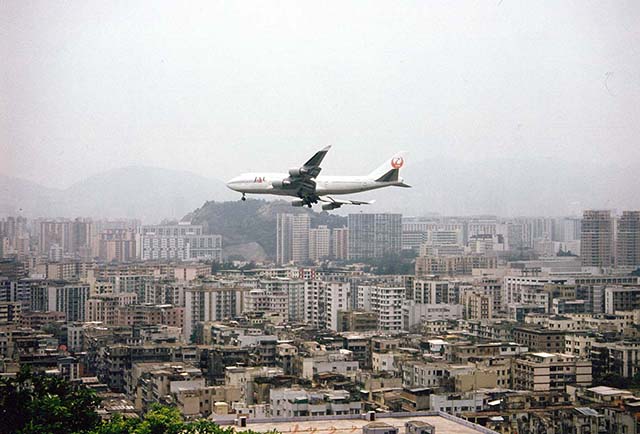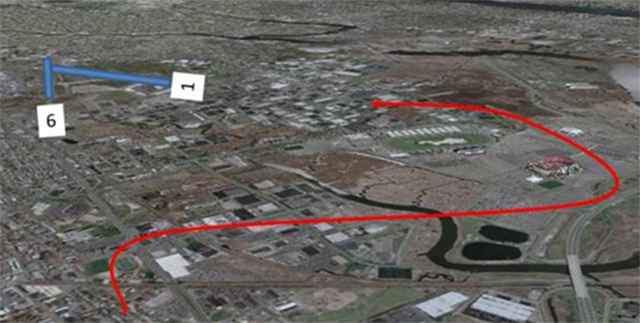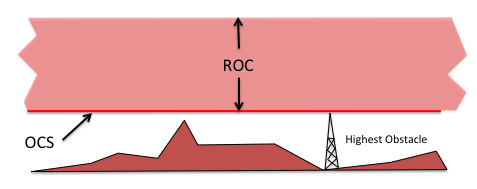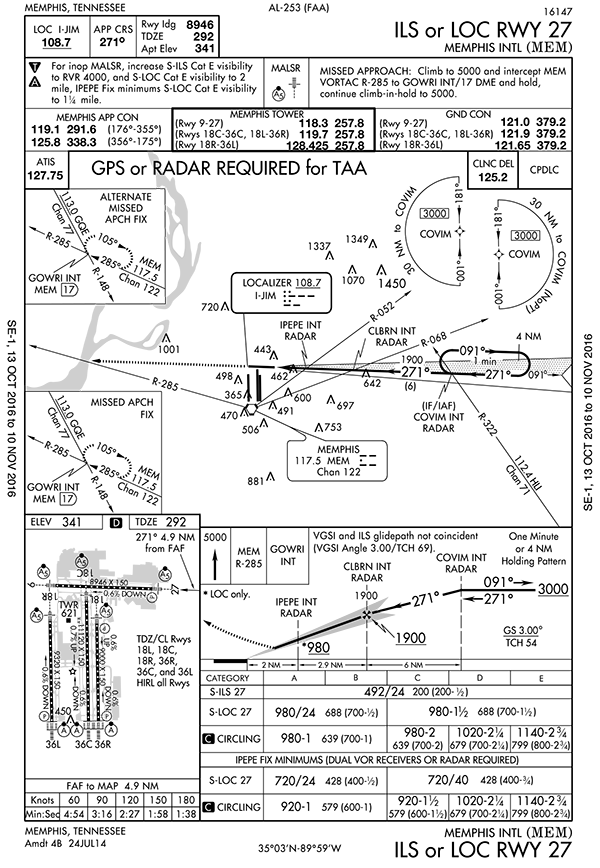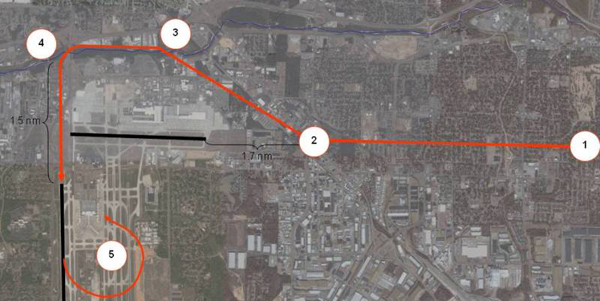Circling at minimums can get you killed so you need to know how the approach was constructed, the procedures for the country you are flying in, and good techniques to keep you out of harm's way. Things are getting easier but if you are circling at an unfamiliar airport you need to plan ahead!
— James Albright

Updated:
2016-10-13
Your first decision is about your approach category and that isn't as cut and dried as you were led to believe on day one of instrument school. Then you need to understand how this and your actual maneuvering speed impacts your circling approach area and what your required obstacle clearance is. You need to understand how to best maneuver your airplane to keep within this area. Finally, you need to know what to do if you lose sight of the runway and have to go missed.
Pre-brief what you are doing to do and figure out how to put most of the stick and rudder chores on the autopilot. If you know you will need 700 fpm in a descending turn to final, why not let George do that while you keep an eye outside? Also brief what you are going to do if you have to go missed. It isn't always turn to the landing runway under ICAO Circling Procedures and for some US approaches you may not want to do that during some phases of the approach. If the other pilot knows what you plan to do, he/she will be better able to support you when things go wrong. Not that anything ever goes wrong.
1 — When is a straight-in approach really a circling approach?
2 — When is a circling approach really a straight-in?
3 — When is a circling approach really just a VFR pattern maneuver?
6 — Required Obstacle Clearance (ROC)

1
When is a straight-in approach really a circling approach?
The books are filled with exceptions, but in general:
- If the final approach course is not within 30° of the extended runway centerline.
- If the descent gradient is more than 400 feet per nautical mile in the final segment.
- If the final approach course crosses the centerline.
Why no definitive statement here? Because there are so many exceptions which depend on where the navaid is (on airport or off?), where does the final approach course intersect the extended centerline (with 5,200 feet, 3,000 feet, and so on.). We as pilots are left to study the approach plate. If it is really confusing, give the airport a call. For example . . .
2
When is a circling approach really a straight-in?
If things don't make sense you can either comb the FAA website for Form 8260 or other waiver forms, or just call up the tower and ask "What gives?" You will more than likely find the airport applied for a waiver because of a special circumstance and the FAA said okay. The KJFK VOR or GPS 13L/13R appear to violate several required obstacle clearance rules for a straight-in approach but there it is. I suspect the airlines insisted on it and they do pay a lot in taxes to support the airport. (Big money talks big, eh?)
3
When is a circling approach really just a VFR pattern maneuver?
We call the "ILS 6 Circle 1" a circling approach but it really isn't, since you begin maneuvering well outside the circling approach area. There are no instrument approaches to Runway 01, though it is often used for arrivals. Arrival usually entails an ILS 06, Circle 01, done outside normal circling airspace starting at DANDY to avoid Giant Stadium. Yes, some pilots circle inside the stadium but when doing this you cannot have a stabilized approach by 500' AGL.
4
Approach categories
Circling approach categories vary between U.S. FAA and ICAO procedures. In either case, a lower category gets you lower ceiling and visibility minimums but also reduces your maneuvering area. You can always raise your category; you have less flexibility in lowering your category that you might think:
- Approach Categories - explains category selection under U.S. FAA versus the ICAO
- Maneuvering Speed - What VA actually means and why it is probably meaningless during your circling approach
Your approach category determines your minimums so raise those minimums when you can. Even if you are a Category C airplane, if the weather permits Category D, use the MDA and circling radius for the higher minimum. I'd rather have 2.3 nm than 1.7 nm any day of the week.
5
Circling approach area
The circling approach is designed to keep you above obstacles within a specified distance away from all landing surfaces. That distance varies ICAO versus U.S. FAA, and even in the U.S. the distance can vary depending on when the approach was designed. You need to know the distance because that tells you when you can start maneuvering and the techniques available to you once you've done that.
- Circling Approach Area - Explains circling approach area under ICAO and U.S. TERPS
- Turn Performance - Explains aircraft turn radius computations
Missed approach procedures. Each pilot operating an aircraft, except a military aircraft of the United States, shall immediately execute an appropriate missed approach procedure when either of the following conditions exist:
(2) Whenever an identifiable part of the airport is not distinctly visible to the pilot during a circling maneuver at or above MDA, unless the inability to see an identifiable part of the airport results only from a normal bank of the aircraft during the circling approach.
Source: 14 CFR 91, §91.175(e)
Is the area large enough? No, be careful out there.
See: (U.S.) Circling Approach Visibility Minimums (Are Too Low!)
6
Required Obstacle Clearance (ROC)
The Circling Minimum Descent Altitude (CMDA) is based on the results of the circling area evaluation and the evaluation of the final segment delivering the aircraft to the circling area. Under U.S. TERPS, a 300 ft Required Obstacle Clearance plus adjustments over the highest obstacle in the Obstacle Evaluation Area is provided. Under ICAO, minimum obstacle clearance is 394 ft for Category C and D aircraft.
More about this: Required Obstacle Clearance.
7
Maneuvering
Determine the Drift
While you on the instrument approach course prior to commencing your circle, make note of the drift required to maintain course. The heading offset needed will be important when you set up a downwind leg.
Offset Heading and Timing
Back in my Boeing 747 days I decided all my circling would be done at 150 knots just to make the math easier. 150 knots is 2-1/2 miles per minute, not as easy as 120 knots which we couldn't do or 180 knots which was above our circling category. That brought up some easy rules of thumb.
Circling Approach 90° Offset
Many pilots use a 15 second offset when approaching a circling runway from a perpendicular heading. They start timing when overhead the runway, 15 seconds later they roll onto downwind. Sometimes it works, sometimes it doesn't. As is turns out, 15 seconds is a compromised number. The real number is slightly lower for an airplane circling at 120 knots, slightly higher for one at 150 knots. Does "slightly higher" or "slightly lower" matter? Perhaps not. But if your ground speed is affected by winds or pressure altitude, it would be nice to know how to adjust, eh?
You will need to time overhead the runway and then you need to turn to the correct downwind heading, adjusted for the winds.
r = 0.69 nm
Time to delay downwind turn after crossing runway at typical Category D speeds:
For typical Category C speeds, 120 knots, r = 0.44 nm, t = 13 seconds
Of course these times do not include the roll in and roll out of the turn, both of which increase the turn radius. Despite this, it may be a good technique to round up to the nearest 5 second increment.

To provide circling offset when approach a runway at 90°, overfly the runway and time for 20 seconds (Category D) or 15 seconds (Category C) before turning downwind.
Circling Approach from the Opposite Runway
This is the classic real world situation and most pilots opt for 30° offset for 30 seconds, but that usually ends up with a very tight base turn. There is a reason for that: 30 seconds isn't enough.
You can use a 30° or 45° offset, your choice, but it is important to get to that heading using a standard rate turn to make the timing work. The objective, of course, it to establish a downwind offset. Once you've done that, you need to adjust that heading for wind. I use 30°, reasoning that you don't need 45° and it is too easy to lose sight with that angular offset.
The distance travelled “d” on that 30 degree leg would be equal to twice the turn radius divided by the sine of 30 degrees. Once again everything hinges on turn radius.
The distance to travel a 30° offset leg:
The time to fly that leg at typical Category D speeds:
For typical Category C speeds, r = 0.44, d = 1.76, t = 53 seconds.

To provide circling offset when approaching from the opposite runway, turn 30° away from heading, time for 66 seconds (Category D) or 53 seconds (Category C), and then turn to parallel the runway on downwind.
8
Applying the math to real life
You seldom find runways laid out as the mathematician in you would have it. You need to adjust these rules of thumb to fit the airport at hand...
Circling Approach Example: GV into Kennedy
RNAV (GPS) Y Rwy 4R requires 700-1 3/4
Arrive at FAF configured, around 125 KCAS, LNAV
FAF at 1500' is 4.4 from Rwy 4R, using 1,000 fpm will be at 640' MDA in about a minute with over 2 miles to runway
Preset HDG to 075
Passing 1.7 nm to runway (visually passing Conch's Hole Point), HDG SELECT and start timing
Turn to parallel runway at 1 minute (visually just outside the Inwood Golf Course)*
Runway 31R is north of 4R/22L by 1/3 mile, approach lights cross 22L touchdown zone
Plan to departing MDA when rolling into turn-to-final, V/S -700 ought to work
Plan to roll out around 300'
*The timing math given previously is 72 seconds for the entire leg geometry, that is, from starting the roll into the offset leg to completing the roll out to parallel. If you start the timing just prior to starting the roll for the offset, 60 seconds ought to work for a point when starting the roll for the parallel leg.
Circling Approach Example: GV into Memphis
First, let's get this straight: you are not going to have to circle at Memphis unless you are in a simulator. So, just in case you are in a simulator flying a Category C Gulfstream V, here's how to do it.
CLBRN is a radar fix. Preselect the 980' MDA in the altitude select window, fly the localizer inbound. In the GV fully configure to gear and 20° flaps, expect an approach speed around 120 knots. Passing CLBRN select full flaps and V/S -1300. The approach plate hints that dual VOR receivers are good enough to bring you down to 920' after IPEPE but I think you would be better off with radar confirmation of the fix. However you want to do it, if you know you've passed IPEPE, descend to the 920' MDA.
Once level at the MDA, preselect a 30° right heading. The GV FMS will show distance to end of runway, you cannot turn until 1.7 nm in a category C aircraft. At this point you might also see a railroad track. Turn 30° right and start timing.
The geometry of these runways mean you only need half the offset of a full 180° turn; plan on turning to parallel original course around 30 seconds. You may also see a river, turn just outside.
You should be able to pick up the Runway 18R approach lights. Turn to roll out on course. Because the runway is still 1.5 miles away, you don't need to begin descending until wings level inbound.
The missed approach runs straight out from runway 27. A good technique is to plan going straight out until you've passed the approach end of 27, at that point plan on turning back to 27 and then outbound. Once you've made the turn to 18R final, plan on a full left 270° turn. See Missed Approach, below, for more.
Circling Approach Example: G450 into Chicago Midway
Chicago Midway will normally use an ILS to 31C circle to 22L if the winds demand it. You can do this inside of the Category D circling approach area and still have a stabilized approach by 500' AGL. You cannot do this using Category C minimums, but tower doesn't expect you to, so use Category D. Also, don't fall the trap of following the roads, they will bring you in too tight.
9
Missed approach
A missed approach will be executed immediately ... whenever an identifiable part of the airport is not distinctly visible to the pilot during a circling maneuver at or above MDA, unless the inability to see an identifiable part of the airport results only from normal bank of the aircraft during the circling approach.
Source: 14 CFR 91, §91.175 (e)
If visual reference is lost while circling-to-land from an instrument approach, execute the appropriate MAP. You should make the initial climbing turn toward the landing runway and then maneuver to intercept and fly the missed approach course.
Source: Instrument Flying Handbook, pg. 10-22
If visual reference is lost while circling to land from an instrument approach, the missed approach specified for that particular procedure must be followed. The pilot will make an initial climbing turn toward the landing runway and overhead the aerodrome. At this point, the pilot will establish the aircraft climbing on the missed approach track.
Source: ICAO Doc 8168, Vol I, §4, ¶7.4.1
In the United States many instrument pilots speak of making the initial missed approach turn to the approach runway, but that isn't what the books say. The initial turn is normally to the landing runway but that doesn't always work. The bottom line is you want to stay inside protected airspace and you should consider your options before you begin the approach. The simulator exercise into Memphis is a perfect example.
Let's say you are making the approach to Runway 27, circling north for a left base to Runway 18R. If you initiate the missed approach anytime after making a right turn to downwind and before completing your left turn to final, it would be best to make an "S turn" to position yourself on top of the approach runway and following the straight-in missed approach instructions. This keeps you in protected airspace. Make a turn to the landing runway is okay at first, but completing what amounts to a 270° turn could leave you north of protected airspace by the time the turn is complete.
Let's say you've already turned to the landing runway and decide you can't make the landing. The missed approach course is behind you. Making a left 270° is exactly what you need here.
You need to brief your missed approach plan before you begin the approach. In some countries, Denmark has many examples, the missed approach procedures following a circling approach, are approach specific. They do not follow what we would consider U.S. FAA or ICAO standard procedures.
References
(Source material)
14 CFR 91, Title 14: Aeronautics and Space, General Operating and Flight Rules, Federal Aviation Administration, Department of Transportation
FAA-H-8083-15, Instrument Flying Handbook, U.S. Department of Transportation, Flight Standards Service, 2001.
ICAO Doc 8168 - Aircraft Operations - Vol I - Flight Procedures, Procedures for Air Navigation Services, International Civil Aviation Organization, 2006
United States Standard for Terminal Instrument Procedures (TERPS), Federal Aviation Administration 8260.3B CHG 25, 03/09/2012
